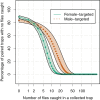Field evaluation of female- and male-targeted traps for Ceratitis capitata (Diptera: Tephritidae)
- PMID: 38936416
- PMCID: PMC11318616
- DOI: 10.1093/jee/toae139
Field evaluation of female- and male-targeted traps for Ceratitis capitata (Diptera: Tephritidae)
Abstract
Mediterranean fruit fly (Medfly) Ceratitis capitata (Wiedemann) (Diptera: Tephritidae) is a globally significant economic pest for which lure based trapping can be used to monitor established populations and for surveillance. Either female- or male-targeted traps can be used; however, recommendations on which to apply are inconsistent and many programs rely on male-targeted traps. Here, we compare the performance of male-targeted traps (Lynfield Trap with Trimedlure) and female-targeted traps (Biotrap Globe trap with the 3-component lure-TMA Plus) in apple orchards in south-west Western Australia over 2 years (September 2019 to September 2021). Male-targeted traps caught more Medflies overall than female-targeted traps, although the difference was minor. However, female-targeted traps were better at attracting Medfly early in the season when populations were small; and were more likely to capture at least one fly when their paired male-targeted trap caught none. Conversely, male-targeted traps were more likely to capture Medflies late in the season and were more likely to catch high numbers of Medflies. Consequently, female-targeted traps may be better at detecting Medfly early in the season, and male-targeted traps may be better at detecting Medfly abundance late in the season, at least in apple orchards. Our results suggest that either or both trap-types could be used for monitoring Medfly populations, with the optimal solution being dependent on the intended application.
Keywords: attractant; ecology andand population dynamics; horticultural entomology; monitoring; surveillance.
© The Author(s) 2024. Published by Oxford University Press on behalf of Entomological Society of America.
Figures






References
-
- Belda M, Holtanová E, Halenka T, Kalvová J.. Climate classification revisited: from Köppen to Trewartha. Clim Res. 2014:59(1):1–13. 10.3354/cr01204 - DOI
-
- Broughton S, Rahman T.. Evaluation of lures and traps for male and female monitoring of Mediterranean fruit fly in pome and stone fruit. J Appl Entomol. 2017:141(6):441–449. 10.1111/jen.12360 - DOI
-
- Broughton S, Rahman T, Woods B.. 2015. Sustainable management of Medfly without cover sprays. Final report (MT12012). Sydney, Australia: Horticulture Innovation Australia (HIA Ltd).
Publication types
MeSH terms
Substances
Grants and funding
LinkOut - more resources
Full Text Sources

